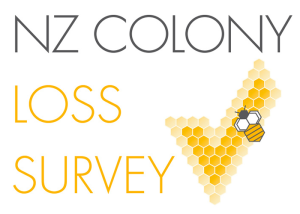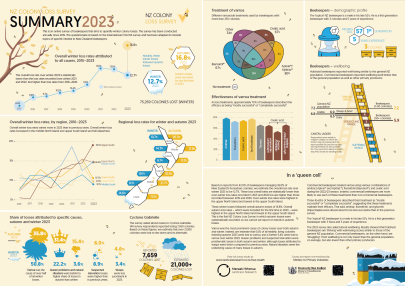2023 Colony Loss Survey
In this section
 Conducted annually since 2015, the New Zealand Colony Loss Survey is based on the survey of beekeepers developed by the international COLOSS honey bee research association.
Conducted annually since 2015, the New Zealand Colony Loss Survey is based on the survey of beekeepers developed by the international COLOSS honey bee research association.
Survey topics include the number and nature of over-winter colony losses, queen health and performance, indicators of diseases and parasites, treatment of Varroa, supplemental feeding, and colony management. Because the challenges facing New Zealand beekeepers differ from those facing beekeepers in the northern hemisphere, the survey also includes questions that are specific to the New Zealand context, e.g. apiary crowding, predation by wasps, and nectar flow from native trees.
In a "queen cell"
Based on reports from 42.6% of beekeepers managing 35.0% of New Zealand’s honeybee colonies, we estimate the overall loss rate over winter 2023 to be 12.7%. These loss overall rates are statistically lower than over-winter loss rates recorded in 2021 and 2022 but are higher than those recorded between 2015 and 2020. Over-winter loss rates were highest in the upper North Island and lowest in the upper South Island.
These winter losses followed overall autumn losses of 16.8%. Overall autumn loss rates – which were included for the first time in 2023 – were highest in the upper North Island and lowest in the upper South Island. This is the first NZ Colony Loss Survey in which autumn losses were systematically recorded, so we cannot yet report on trends in autumn losses.
Varroa was the most prominent cause of colony losses over both autumn and winter. Indeed, we estimate that 5.6% of all healthy, living colonies entering autumn 2023 were lost to varroa, and a further 6.4% were lost to varroa over winter 2023. Queen problems and suspected starvation were problematic issues in both autumn and winter, although losses attributed to wasps were down compared to previous years. Natural disasters were the underlying cause of many losses in autumn.
Commercial beekeepers treated varroa using various combinations of amitraz (Apivar® and Apitraz®), flumethrin (Bayvarol®), and oxalic acid during the 2022/23 season. Indeed, commercial beekeepers are more likely to use each of these treatments than non-commercial beekeepers.
Three-fourths of beekeepers described their treatment as “mostly successful” or “completely successful”, suggesting that these treatments maintain their efficacy. That said, amitraz, flumethrin, and glycerin strips/staples were all perceived to be less successful than in the previous survey.
The ‘typical’ NZ beekeeper is a male in his late 50’s. He is a first generation beekeeper with 3 hives and 5 years of experience.
The 2023 survey also asked about wellbeing. Results showed that hobbyist beekeepers are ‘thriving’ with well-being scores similar to those of the general NZ population. Commercial beekeepers, on the other hand, are ‘struggling’. Their wellbeing is not only lower than the general population, on average, but also lower than other primary producers.
Summary











2023 autumn losses








2023 winter losses












Varroa













Beekeeper wellbeing
















